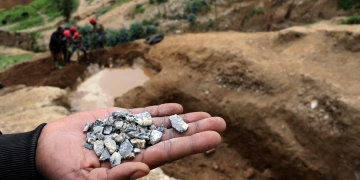Sudanese Returnees Face Overwhelming Challenges as They Begin to Rebuild Their Lives
After months and, in some cases, years of displacement, thousands of Sudanese are now making the difficult journey back to their homes following the recent lull in fighting across parts of the country. Yet, what awaits them is not the life they once knew. The return home has become a new struggle — one defined by destroyed infrastructure, scarcity of basic needs, and the emotional scars of war.
Ruins Instead of Homes
Many returnees are finding that their houses no longer exist. Neighborhoods once filled with families are now shells of destruction, their walls marked by bullets and roofs caved in from shelling. In Khartoum, Omdurman, and parts of Darfur, residents describe their return as “starting from zero.” Roads are littered with debris, bridges are damaged, and power lines have collapsed.
For those who fled to neighboring countries like Egypt, Chad, and South Sudan, the journey back home is both financially draining and emotionally taxing. Families often travel in overcrowded trucks, carrying only the belongings they managed to save. Upon arrival, they are met with silence—no running water, no electricity, and no functioning markets. The country’s basic infrastructure, already fragile before the war, is now on the verge of total collapse.
Absence of Basic Services
Access to essential services remains one of the greatest hurdles. In many parts of Sudan, clean drinking water is almost impossible to find. Wells have been contaminated or destroyed, forcing families to walk long distances to fetch water. Health facilities that once served thousands are now non-functional or severely understaffed. Doctors and nurses who fled during the height of the conflict have not returned, and those who remain face overwhelming pressure to attend to large numbers of patients without adequate medical supplies.
Education has also been heavily affected. Schools across war-torn regions are either destroyed or occupied by displaced people. Children who have spent years out of school now face an uncertain future. Parents worry about their children’s lost learning and the long-term effects of growing up amid violence and displacement.
Legal and Land Disputes
Another major challenge is the loss of legal documentation. Many returnees fled without national identification cards, land titles, or birth certificates. Without these documents, they cannot access government services, register their children for school, or reclaim property. In some cases, returnees discover that their homes and farmland have been taken over by others during their absence, leading to bitter land disputes.
Local authorities lack the capacity to resolve these disputes effectively. The absence of functioning courts and administrative offices leaves many families in legal limbo, further delaying the process of rebuilding their lives.
Security and Safety Concerns
Despite the apparent calm in some areas, the security situation remains volatile. Armed groups still control several parts of the country, and sporadic fighting continues to break out. In cities like Khartoum and Nyala, looting and harassment are common, particularly at night. Many returnees say they do not feel safe walking after dark.
The presence of unexploded bombs and landmines adds another layer of danger. Humanitarian organizations are working to clear affected areas, but progress is slow, and many regions remain unsafe for resettlement. Women and children are particularly vulnerable, with cases of gender-based violence reported in some return areas.
Economic Hardship and Hunger
The economic collapse is perhaps the most visible sign of Sudan’s crisis. Inflation has skyrocketed, the local currency has lost much of its value, and food prices have doubled in recent months. Many returnees have lost their jobs, farms, or livestock. Markets that once bustled with trade are now empty or operating at minimal capacity.
In rural areas, farmers struggle to find seeds and equipment to restart agricultural activities. The lack of fuel and fertilizers has made cultivation nearly impossible. As a result, food shortages are becoming more severe. The World Food Programme (WFP) has warned that millions of Sudanese are on the brink of famine if aid does not reach them soon.
Humanitarian agencies are trying to fill the gap, but their efforts are hampered by funding shortages and logistical challenges. Aid convoys face roadblocks, insecurity, and damaged infrastructure. Despite the dire need, only a fraction of the requested humanitarian funding for Sudan has been received this year.
Emotional and Psychological Trauma
Beyond the physical destruction lies another invisible crisis — trauma. Many returnees carry the deep psychological wounds of war. They have witnessed killings, lost loved ones, and endured years of uncertainty in refugee camps. For children, the memories of explosions and displacement have left lasting scars.
Mental health services are almost non-existent in most parts of the country. Psychologists and social workers are few, and the cultural stigma around seeking help often prevents people from addressing their trauma. Some humanitarian organizations are trying to provide group counselling sessions and community-based healing activities, but these efforts remain limited.
Women Bearing the Heaviest Burden
Women are among the hardest hit by the crisis. Many have lost their husbands and now shoulder the responsibility of providing for their families. In camps and return areas, reports of sexual violence and exploitation are increasing. Without adequate protection, women and girls remain at risk when fetching water, collecting firewood, or walking long distances to reach aid distribution points.
Despite the hardship, many Sudanese women continue to show remarkable resilience. Some are starting small businesses such as selling food, sewing clothes, or trading household goods. These efforts, though small, provide a glimmer of hope amid the devastation.
Signs of Resilience and Hope
Despite overwhelming odds, stories of resilience are emerging. Communities are banding together to rebuild damaged homes and clear debris from streets. In parts of Khartoum, residents have started using solar panels to generate electricity for basic lighting. In rural areas, farmers are pooling resources to restart cultivation where land is safe.
Local organizations and international partners such as the International Organization for Migration (IOM) and the UN Refugee Agency (UNHCR) are supporting returnees with cash assistance, document recovery, and health care. These programs have helped some families restart their lives, though the need far exceeds available resources.
What Needs to Be Done
Experts say Sudan’s recovery will require a coordinated national and international effort. Rebuilding infrastructure, restoring essential services, and ensuring security must be top priorities. Legal reforms are needed to help returnees reclaim property and access civil rights.
Humanitarian aid must also be scaled up to meet the growing needs. Without sufficient funding, millions risk falling deeper into hunger and poverty. In addition, psychosocial support programs must be expanded to help people heal from years of conflict and displacement.
Most importantly, long-term peace must be secured. Without political stability, all reconstruction efforts will remain fragile. The international community continues to call for renewed dialogue among Sudan’s rival factions to end the cycle of violence once and for all.
The Road Ahead
For Sudanese returnees, homecoming is both a relief and a test of endurance. The road to recovery is long and uncertain, but it is also filled with determination and faith. As one returnee in Khartoum told reporters, “We came back because this is our land. We may have lost everything, but we will build again, stone by stone.”
Their journey reflects the resilience of an entire nation — battered but unbroken, hopeful that peace and stability will one day return to Sudan.








